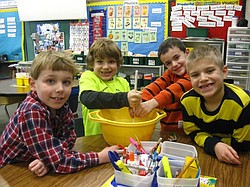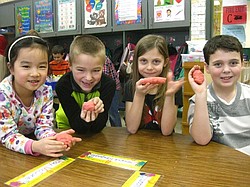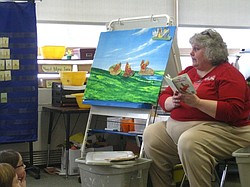C.H. Campbell first-graders learn about helping
Neighbors | Abby Slanker.A group of C.H. Campbell Elementary School first-graders worked together as a team to mix up a batch of play dough after listening to a reading of “The Little Red Hen” by Brenda Markley, Mill Creek MetroParks Farm agriculture education program manager, Feb. 19.
Neighbors | Abby Slanker.A team of C.H. Campbell Elementary School first-graders showed off their end product of pink play dough, which was made during a visit from Brenda Markley, Mill Creek MetroParks Farm agriculture education program manager, Feb. 19.
Neighbors | Abby Slanker.Brenda Markley, Mill Creek MetroParks Farm agriculture education program manager, visited Jan Johnson’s first-grade class at C.H. Campbell Elementary School to share her favorite farm story, “The Little Red Hen” Feb. 19.
By ABBY SLANKER
Brenda Markley, Mill Creek MetroParks Farm agriculture education program manager, visited all four C.H. Campbell Elementary School first-grade classes and shared her favorite farm story with the students Feb. 19. Markley read the students her childhood favorite, “The Little Red Hen.”
“I was told you were working on reading and I wanted to come here and share my favorite farm story with you from when I was a little girl. ‘The Little Red Hen‘ was written in the late 1800s, so it has been around for more than 100 years,” Markley told the students.
Markley brought a story board with her so the students could follow along the children could visualize it. As the story progressed, Markely added cutouts of the characters made out of felt, which depicted what the characters were doing in the story.
“We have three characters in this story, aside from Little Red Hen. We have the duck, dog and cat. As we go along, you can act out a characteristic of the characters each time one is mentioned. For the duck, you can waddle in your seats, for the dog you can put you hands up like paws and bounce and for the cat you can curl up with their hands on the side of their faces and pretend to nap,” Markley said.
In the story, Little Red Hen asked her three friends, the duck, the dog and the cat, to help her plant wheat seeds. When they all say no, she does it herself. When the wheat was grown, Little Red Hen asked her friends to help her cut it. When they said no again, she cuts the wheat herself.
When the wheat was cut, Little Red Hen asked her friends to help her take it to the mill and have it ground into flour. When her friends, once again, said no, she took the wheat to the mill herself. After she brought the sack of flour back to her house, she asked her friends to help her bake bread. Again, they said no, so she baked the bread herself.
When the bread was ready, she asked them who would help her eat the bread. This time, the duck, dog and cat all said they would help. And Little Red Hen, said no and ate the bread herself.
“There are several versions of this book with several different characters. No matter which version you read, the ending is always the same. Little Red Hen’s friends never get the bread because they never helped her,” Markley said.
Markley brought with her items from the farm to show the children, like wheat seeds and grown wheat.
“Today I am bringing the farm to you,” Markley said.
„ÄÄMarkley applied what happens in the story to what happens on the farm. She explained that at the farm, it is the farmer’s job to plant the wheat seeds and take care of it while it grows. The farmer then receives help from a combine to harvest the wheat. Markley explained this process with the help of a toy combine she brought with her.
After harvesting, she said, the farmer’s job is done as he sells the wheat to the mill. The mill grinds the wheat into flour and people can then bake bread, muffins, cookies, pancakes, spaghetti or tortillas with the flour.
“What I want you learn from this story is to think about helping. It’s a good idea. It makes you feel warm and fuzzy. And sometimes you might get a special reward, like in the story,” Markley said.
As a special treat for the students, and much to their delight, Markley announced she brought all the ingredients for them to make dough, but since there was no oven to bake it in, they would make play dough.
The only stipulation was the students had to work as a team, unlike the characters in the story. Each team member was assigned a job. One student added the bag of flour to the bowl. The next student added the water to the flour. The next student added the salt to the mixture and the next student added the oil. The last ingredient was a package of Kool-Aid to provide color and scent. Each student then had a chance to stir the mixture.
“You all help each other and work as a team to make the play dough,” Markley told the children. “Each of you has a job and all these jobs need to be combined to make the end product.”
When the mixing and stirring was done, Markley handed each child their own ball of play dough. The children wasted no time getting creative and making things out of the play dough, like a pretzel, a heart, a doughnut, snakes and clown noses.
 43
43



